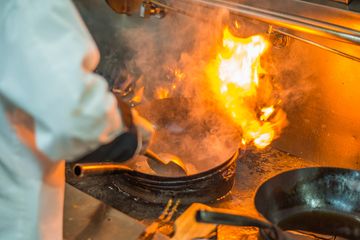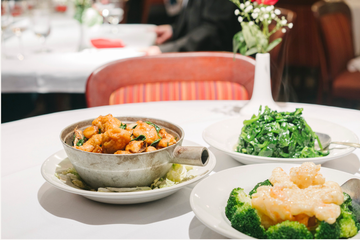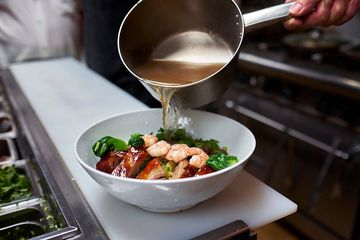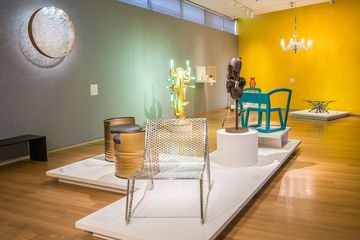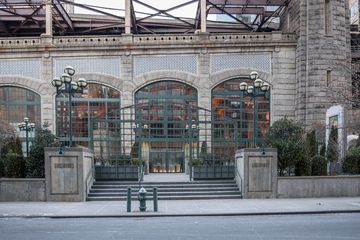I believe we saw one of the great wonders of the world when we were invited into the kitchen to see Philippe Chow work. The original chef for Mr. Chow's on East 57th Street for some twenty plus years and the man for whom the restaurant is named, Philippe’s speed and skill with a wok is unparalleled. After exiting the amazing heat and chaos roaring from Philippe’s metaphoric engine room, Steve Boxer, one of the very kind owners, exclaimed “And this is just lunch! ”The kitchen was the last stop on a tour of Philippe’s impressive restaurant, which includes several special places to indulge in the fine menu. There is a sleek, newly renovated bar, an expansive upstairs complete with its own bar, and a classic dining room with black banquettes and white tablecloths, known as the “Runway Room” for all the celebrities it attracts. One of the hidden highlights was the double wine cellar, which has tables and chairs set up between the rows of wine bottles, making for a more private, cozy, nocturnal setting. Guests sitting below ground can select their own music to play on the separate sound system using iPods or watch the flatscreen TV. At the end of our tour, Steve brought us to the “Skylight Room, ” which he says is a favorite spot for families, since it has a lot of natural light and has booth seating for kids to sprawl on, if necessary. It was clear to us that there is a place to sit for anyone, whether casual or classy, depending on one's mood. We sat down in the Skylight Room to enjoy some of Philippe's signature dishes and to continue our conversation with Steve. The Manhattan Sideways Team sampled the green prawns with carrots, mushrooms, and cashews, the vegetarian lettuce wrap with plum sauce, and the Beijing chicken with walnuts. Of the last dish, Steve said, “It’s like candy! ” and biting into one of the impossibly sweet walnuts, I agreed with him. He explained that there were healthy options, such as steamed vegetables and fish, and that they would be launching a light summer menu that he hoped would remain all year, including an eggplant dish and poached salmon. Ultimately, though, Steve believes that people do not come to Philippe to keep to their diet. He smirked and said, “Personally, I come here to sin. ”Steve sat and ate with us, and we were delighted to find that the owner of such a highly regarded restaurant was so down-to-earth and willing to chat. At one point he took out his phone to show us a picture of his dog in a baseball cap and had to flip past numerous photos of Rihanna’s party that she catered through Philippe the night before, perfectly demonstrating his friendly, casual nature. Steve is Manhattan born-and-bred, and so he knows exactly what New Yorkers want out of a restaurant. He has a lot of exciting plans for the Philippe empire: "I have closed quite a few locations recently, in an effort to regroup and reopen ten times better than before, " he explained. He continued, “I joined this venture looking for my own version of Cheers. I love it. ” He then mentioned that when he was finished showing off his east 64th Street location to us, he was headed to the Hamptons where he is about to open another Philippe. In addition to spending time with Steve and Chef Philippe, we met Kostas Paterakis, the floor manager and pastry chef. Due to his interesting combination of jobs (manning the floor and baking his treats), he often finds himself alone in the kitchen creating delectable desserts well into the night. He was not complaining, however, but declaring that he does his best work when left alone to experiment. The unexpected list of dazzling desserts on the Chinese menu include red velvet cake, apple cobbler, and selection of sorbets. "And everything is made in-house, " Steve proudly announced, and it all comes from what Steve calls “Kostas's little Betty Crocker Oven. ”We enjoyed observing the repartee between Kostas and Steve: After receiving a compliment from the owner, Kostas said, “I’d buy you a drink if it wasn’t your place. ” Later he said of Steve, “He listens to us as much as the customers, which is a big deal to the staff. He’s a great owner. ” Then he turned with an impish grin to Steve: “That’s what you told me to say, right? " Steve rebutted with, “I am blessed with the most loyal, trusting group of people. They treat this place like it’s their own. ”
